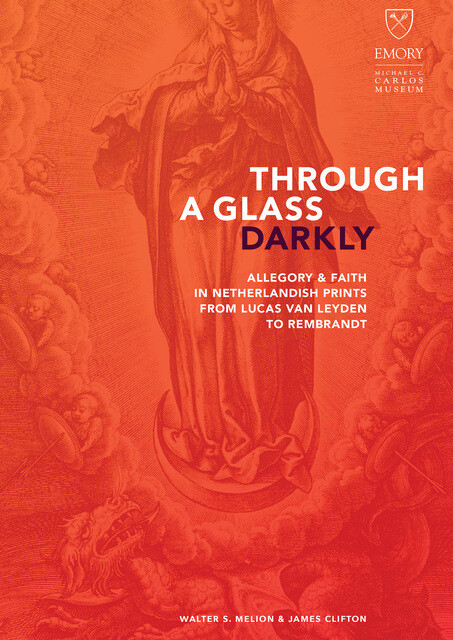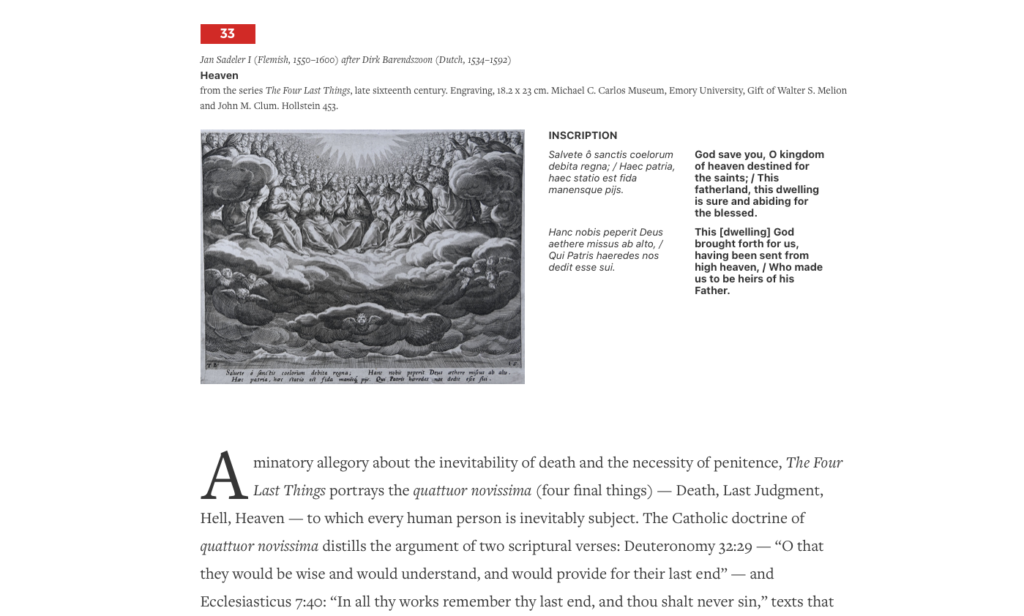A collaborative project between the Emory Center for Digital Scholarship (ECDS) and the Fox Center for Humanistic Inquiry (FCHI) is now published as an open access, enhanced digital monograph. “Through a Glass, Darkly” is a richly illustrated catalogue detailing exhibition materials that systematically consider the form, function, and meaning of allegorical prints produced in the Low Countries during the 16th and 17th centuries. The exhibition was co-curated by Emory Professor of Art History, Dr. Walter Melion, and Dr. James Clifton, Director of the Sarah Campbell Blaffer Foundation.
By Walter Melion
Asa Griggs Candler Professor of Art History, Emory University
Through a Glass, Darkly: Allegory and Faith in Netherlandish Prints from Lucas van Leyden to Rembrandt explores the centrality of visual allegory to religious culture in the Low Countries between 1500 and 1650. The book, which takes the form of a monographic catalogue in print and also as an open access publication with video commentary and deep zoom imagery, originally accompanied an exhibition held at Emory University’s Michael C. Carlos Museum in Fall 2019. In organizing the exhibition, my co-curator, James Clifton, and I posed the question: How religious-minded viewers used printed allegorical images to engage with the mysteries of faith, ponder religious doctrine, and interpret the Bible? The ninety engravings and etchings on which the show focused, dating from ca. 1500 to ca. 1700, many in the permanent collections of Emory’s rare book libraries and Michael C. Carlos Museum, others generously loaned to us by the Metropolitan Museum of Art, the New York Public Library, and other institutions, served as our case studies.
The term allegory—etymologically, “other speaking”—alludes to a process whereby the images of persons, objects, or events come to stand for conceptions variously distant from them. Take the apple or, better, the action of eating one: depending on context and circumstance, this could signify the fall of Adam and Eve; but in another context, with reference to different circumstances, it might instead signify the seductive power of Venus, goddess of desire. The relation between the thing visualized and the conception signified is often analogical. To eat the apple, the fruit of forbidden knowledge, is analogous to tasting ‘forbidden fruit’ of any sort; to partake of the apple of Venus is analogous to seizing the object of one’s desire, indulging in the joys (but also the sorrows) of the flesh. And so forth.
Allegorical thinking was virtually endemic in the 16th– and 17th-c. Low Countries, largely because Christ himself, on the model of the prophets, justified and exemplified allegorical usage in his parables. These are stories that mobilize familiar persons and things to epitomize moral precepts and exemplify religious doctrine. Allegory was used by common folk and by members of elite society; it was preached from pulpits, permeated prayers and homilies, and decorated church buildings, both inside and out. In short, it was everywhere the common currency of religious discourse. If we’re to understand how early modern people living in one of the great centers of religious image-making—the Low Countries (Northern France, Belgium, the Netherlands, and Luxemburg)—experienced and commented upon their faith, we need to familiarize ourselves with allegory.
The engravings and etchings comprised by the exhibition and featured in the catalogue have been grouped into five sections, following a typology designed to elucidate processes of allegorical image-making.
- Stilled Allegory consists of persons or things that embody, rather than enact, a pictorial meaning; its mode of address is presentational, and it often relies on personification (prosopopoeia) to communicate a message.
- Enacted Allegory consists of persons whose actions narrate the pictorial meaning.
- Parabolic Allegory consists of persons whose actions and circumstances operate as analogues to religious precepts; it is licensed by Christ himself in Matthew 13, Mark 4, and elsewhere.
- Emblematic Allegory consists of persons and things that operate symbolically within an interpretative apparatus made up of both text and image; in its tripartite form, the emblem is composed of a motto (lemma or titulus), a picture (pictura), and an epigram (epigramma). Occasionally a fourth element, an extended commentary, throws light upon how the other three parts connect.
- Heuristic Allegory consists of persons or things whose mutual relation puts forward a problem to be discerned or solved.
Although the catalogue primarily aims to exemplify the five categories outlined above, it also makes every effort to explain the biblical, historical, political, and moral subject matter of the individual works. The categories are either structural or functional rather than iconographic, focusing less on identifying and naming the constituent parts of these allegorical types than on studying the manner and meaning of their connective, interactive organization. These prints were first acquired for the purposes of personal education, devotion, and improvement. They were for the most part designed to be highly affective, requiring that their reader-viewers, both clerical and lay, substantially commit their minds and hearts to the task of reading and viewing them. The exhibition title, which is borrowed from the apostle Paul’s famous remark in 1 Corinthians 13:12, “We see now through a glass, darkly (per speculum in aenigmate); but then face to face: now I know in part; but then shall I know even as also I am known,” points to the interpretative challenge posed by many of these allegorical images. They elicited and responded to reader-viewers’ spiritual desires, engaged their intellective faculties, and sharpened their hermeneutic skills. The Pauline apothegm is also an allegorical metaphor for the obscurity of God’s truth, the inadequacy of human understanding, and the promise of ultimate revelation. Visual allegory was appreciated as a means of achieving, to the best of one’s abilities, whatsoever could be achieved interpretatively in this life, through the application of sense experience, cognitive acumen, and, last but certainly not least, spiritual insight.
Thanks to the valiant, dedicated efforts of Sarah McKee, former Senior Associate Director for Publishing at Emory’s Fox Center for Humanistic Inquiry, and Yang Li, Senior Information Designer at the Emory Center for Digital Scholarship, and with the strong technical support of the ECDS, a revised and amended version of the catalogue has just been published as an open access monograph. This edition of Through a Glass, Darkly has been built on the Manifold platform, the merits of which will, we hope, be immediately apparent to readers and viewers.
Manifold is one of the recommended platforms for Digital Publishing at the ECDS.
Learn more about ECDS Manifold projects and Digital Publishing at Emory University.


